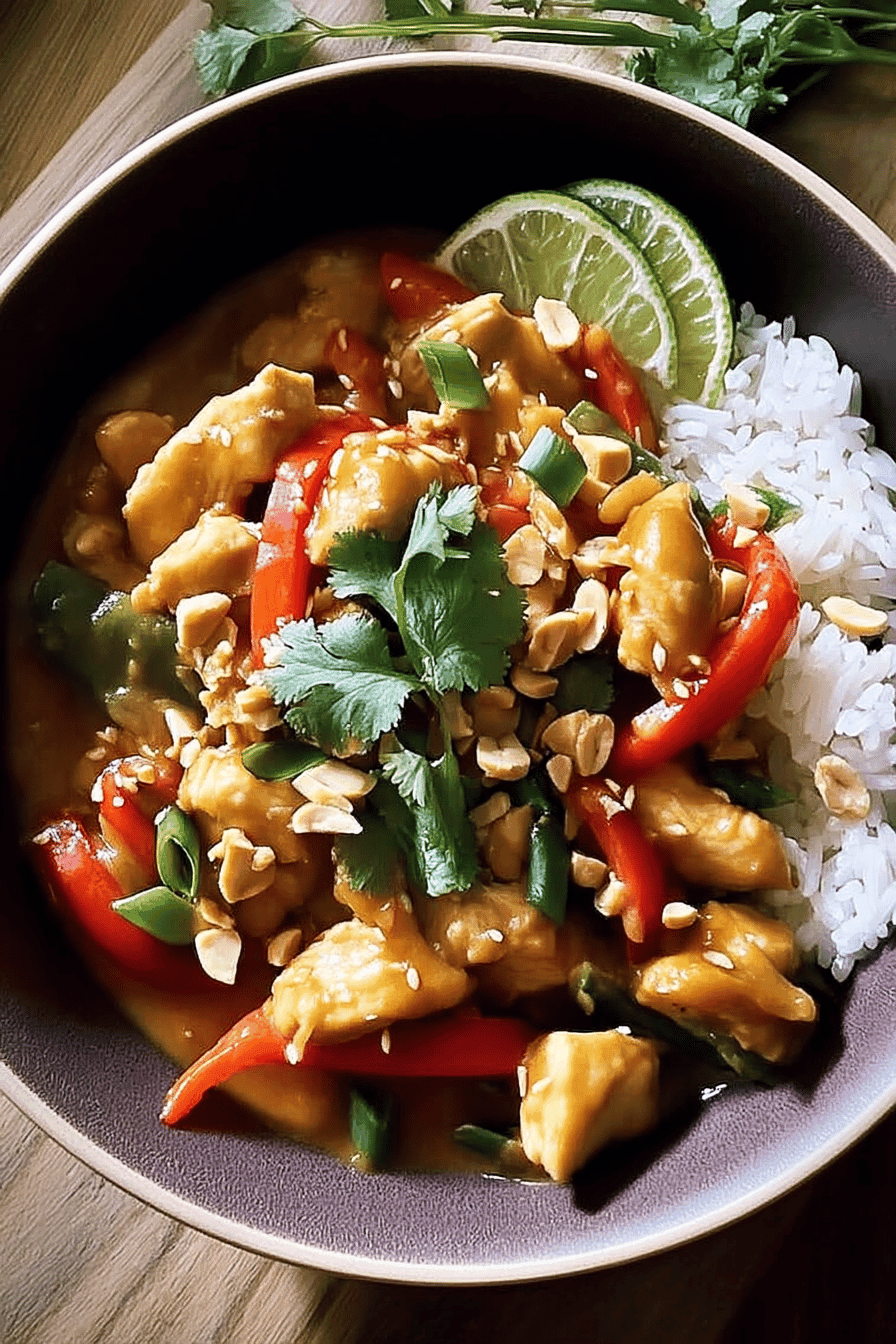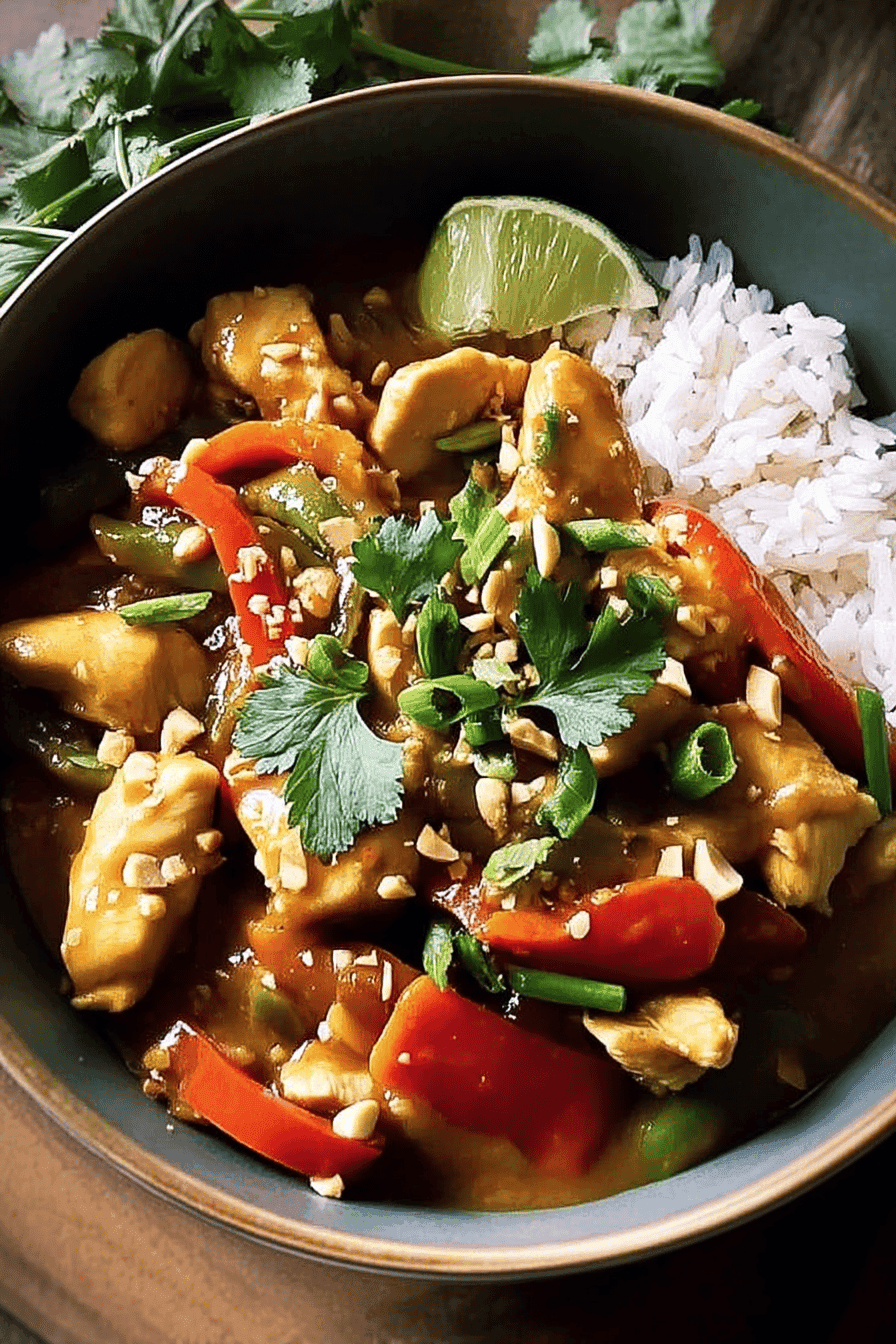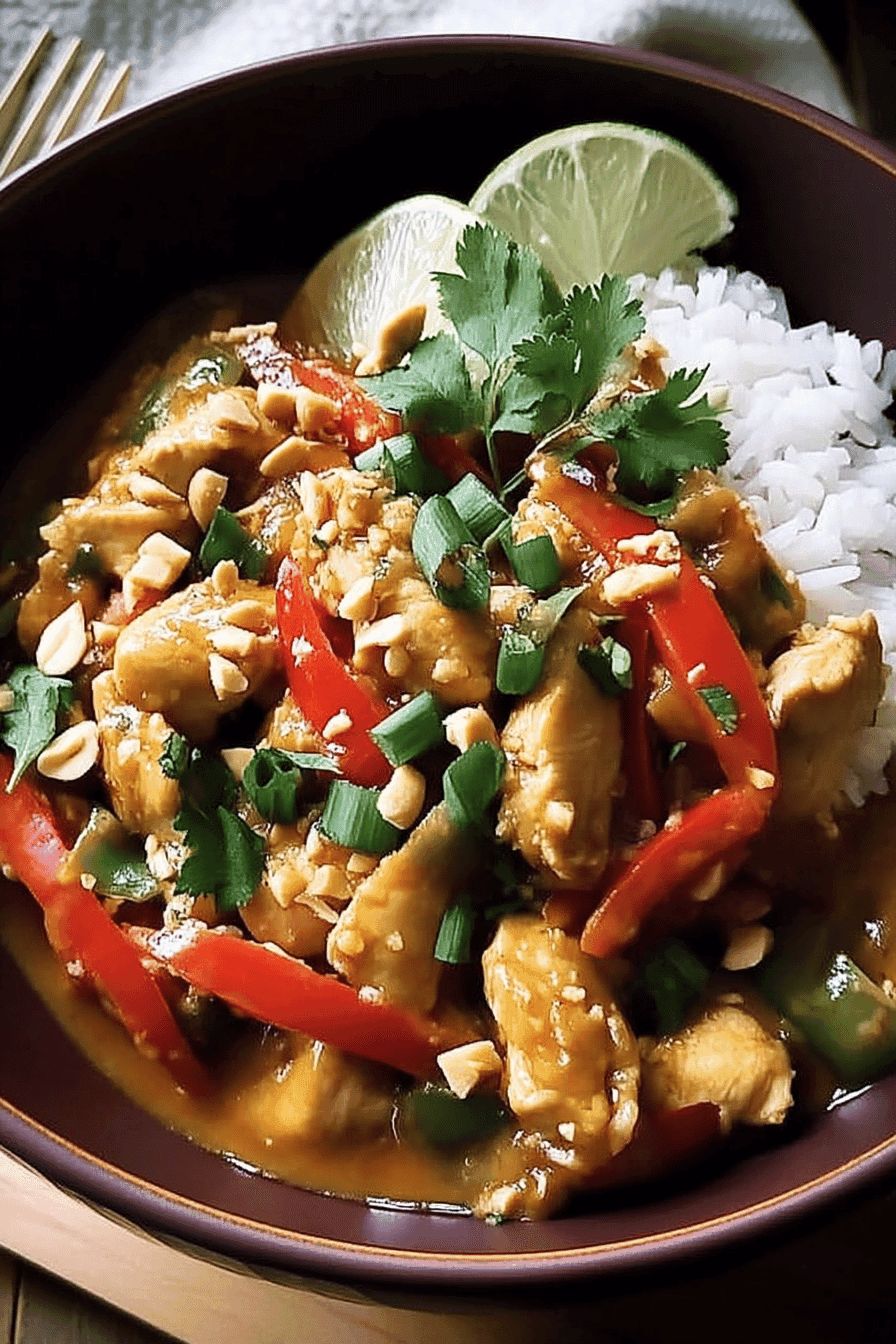Benefits and Advantages of thai peanut chicken stir fry
- Ease of preparation: This thai peanut chicken stir fry recipe is straightforward and quick, using minimal ingredients and simple steps. It’s perfect for busy weeknights when you want a fast, satisfying meal with little fuss.
- Health benefits: Featuring lean chicken protein and a variety of fresh vegetables, this dish provides a balanced profile of protein, vitamins, and minerals. The peanut sauce adds healthy fats and antioxidants, making it a nourishing option that supports overall wellness.
- Versatility: The recipe easily adjusts to different dietary needs. You can swap the chicken for tofu or shrimp to accommodate vegan or pescatarian diets, and use tamari instead of soy sauce to make it gluten-free without losing the distinctive flavors.
- Distinctive flavor: The combination of creamy peanut butter with Thai spices, fresh lime or rice vinegar acidity, and umami from soy sauce creates a unique flavor profile. The contrast of savory and sweet, with a hint of heat, delivers a flavorful and memorable dish.
Jump To
- 1. Benefits and Advantages of thai peanut chicken stir fry
- 2. Essential Ingredients for thai peanut chicken stir fry
- 3. Dietary Substitutions to Customize Your thai peanut chicken stir fry
- 4. How to Prepare the Perfect thai peanut chicken stir fry: Step-by-Step Guide
- 5. Mastering thai peanut chicken stir fry: Advanced Tips and Variations
- 6. How to Store thai peanut chicken stir fry: Best Practices
- 7. FAQs: Frequently Asked Questions About thai peanut chicken stir fry
- 8. thai peanut chicken stir fry
Essential Ingredients for thai peanut chicken stir fry
- 1 to 1½ pounds boneless skinless chicken breasts or thighs, cut into ½-inch pieces – provides lean protein and main texture
- ½ cup creamy smooth peanut butter – adds creamy texture and characteristic richness
- 3 tablespoons water (or ¼ cup) – thins the peanut sauce for a smooth consistency
- 3 tablespoons honey (adjustable between 2 teaspoons and 1 tablespoon) – balances flavor with mild sweetness
- 2 to 3 tablespoons low sodium soy sauce or tamari for gluten-free – delivers umami seasoning
- 3 tablespoons Thai red curry paste or ½ teaspoon to 2 teaspoons red pepper flakes for mild to extra heat – adds spice and depth
- 2 tablespoons rice vinegar or 1 tablespoon lime juice – provides acidity for brightness
- 1 to 2 tablespoons minced fresh ginger – imparts warm, zesty flavor
- 2 to 4 cloves garlic, minced – adds aromatic depth
- Optional: 1 tablespoon toasted sesame oil – nutty aroma and complexity
- 1 medium yellow onion, thinly sliced (optional) – enhances sweetness and texture
- 6 cups mixed chopped vegetables (e.g., napa cabbage, broccoli florets, bell peppers, mushrooms, sugar snap peas, shredded carrots, asparagus) – offers fiber, vitamins, and color
- ½ cup dry-roasted peanuts, roughly chopped – garnish for crunch and visual appeal
- ½ cup chopped fresh cilantro or parsley – adds fresh herbal notes
- Cooked brown rice, rice noodles, or alternative grains like quinoa or soba noodles – for serving
Special Dietary Options:
- Vegan: Substitute chicken with tofu or chickpeas; replace honey with maple syrup to maintain sweetness.
- Gluten-free: Use tamari or coconut aminos instead of soy sauce.
- Low-calorie: Use reduced peanut butter or almond butter, limit oil to a spray, and increase vegetable portions to reduce calorie density.
Dietary Substitutions to Customize Your thai peanut chicken stir fry
Protein and Main Component Alternatives:
- Replace chicken with shrimp for a seafood variation or firm tofu for plant-based protein suitable for vegans.
- Tempeh or seitan are great alternatives that fit vegetarian or vegan diets and provide texture variety.
- For low-carb options, replace rice or noodles with cauliflower rice or spiralized vegetable noodles.
Vegetable, Sauce, and Seasoning Modifications:
- Swap snap peas and bell peppers with broccoli, carrots, zucchini, or asparagus according to seasonal availability or preference.
- Opt for coconut aminos instead of soy sauce for gluten-free sauces.
- Add chili flakes, fresh chili, or sriracha to amp up the heat level.
- Use honey alternatives like agave syrup or maple syrup for different sweetness profiles.
- Add fresh herbs such as cilantro or Thai basil to enhance the authentic Thai flavor aroma.
Try pairing this stir fry with other easy recipes like our Garlic Chicken or Marry Me Chicken Pasta.
For more details on the health benefits of key ingredients, check out Health Benefits of Chicken and Nutritional Value of Peanut Butter. Explore stir-fry techniques in this How to Make a Stir Fry guide.
How to Prepare the Perfect thai peanut chicken stir fry: Step-by-Step Guide
- Prepare ingredients: Slice 1 to 1½ pounds boneless skinless chicken breasts or thighs into ½-inch dice or strips. Chop your mixed vegetables such as napa cabbage, broccoli florets, bell peppers, mushrooms, snap peas, shredded carrots, or asparagus. Mince garlic and fresh ginger.
- Make peanut sauce: In a bowl, whisk together ½ cup creamy smooth peanut butter, 3 tablespoons water, 3 tablespoons honey (adjust sweetness to taste), 2 to 3 tablespoons low sodium soy sauce or tamari, 3 tablespoons Thai red curry paste or desired red pepper flakes, 2 tablespoons rice vinegar or lime juice, 1 to 2 tablespoons minced ginger, 2 to 4 cloves minced garlic, and optional 1 tablespoon toasted sesame oil and brown sugar. Set aside.
- Sauté aromatics: Heat 1 tablespoon oil in a large skillet or wok over medium-high heat. Add thinly sliced onion (optional) and sauté until fragrant and slightly softened, about 3 minutes.
- Cook chicken: Add chicken pieces and stir occasionally until fully cooked with clear juices, roughly 4 to 6 minutes depending on size. Remove chicken and onions from pan; set aside.
- Cook vegetables: Add remaining 1 to 2 tablespoons oil and stir-fry the mixed vegetables until crisp-tender approximately 3 to 8 minutes, starting with firmer vegetables to maintain texture.
- Combine and simmer: Return chicken and onions to the pan. Pour peanut sauce over mixture and toss well. Simmer gently for 2 to 4 minutes to thicken sauce and heat through thoroughly.
- Finish and garnish: Stir in roughly chopped dry-roasted peanuts and chopped fresh cilantro or parsley just before serving. Serve hot with cooked brown rice, rice noodles, or preferred grains.
This step-by-step method ensures balanced flavors, proper cooking consistency, and a delightful peanut aroma throughout your meal.
Mastering thai peanut chicken stir fry: Advanced Tips and Variations
Pro Cooking Techniques
- Use a wok or wide skillet preheated well to develop a good sear on the chicken, locking in juices and flavor.
- Maintain a high heat but stir frequently to prevent burning and encourage slight caramelization of the peanut sauce.
- Add firmer vegetables first, followed by quicker-cooking ones to preserve crispness and texture balance.
Flavor Variations
- Try infusing your sauce with a splash of coconut milk for creaminess and mellow spice.
- Add fresh herbs like basil or lemongrass at the end for a fragrant lift.
- Use tamarind paste for a tangy note or adjust sweetness with brown sugar or maple syrup instead of honey.
- For heat lovers, increase Thai red curry paste or red pepper flakes gradually to taste.
Presentation Tips
- Serve in colorful bowls garnished with fresh cilantro and extra chopped peanuts for texture.
- Accompany with lime wedges to let guests add bright acidity as desired.
Make-Ahead Options
- Prepare the peanut sauce in advance and store it in an airtight container refrigeration for up to 5 days.
- Chop vegetables ahead of time and store them separately to streamline cooking on busy days.
How to Store thai peanut chicken stir fry: Best Practices
| Storage Method | Guidelines | Recommended Duration |
|---|---|---|
| Refrigeration | Place leftover stir fry in airtight containers. Refrigerate within two hours of cooking to avoid bacteria growth. | 3 to 4 days |
| Freezing | Freeze in suitable freezer-safe containers or bags with headspace for expansion. Expect slight texture changes, especially in noodles. | Up to 2 months |
| Reheating | Warm gently on the stovetop over medium heat, stirring to heat evenly. Microwave reheating is fine but stir midway to avoid hot spots. | Consume immediately after reheating |
Separate sauces and starches when freezing to prevent sogginess and maintain ideal textures on reheating.
Batch cooking tip: Prepare peanut sauce and protein separately and mix with freshly cooked vegetables at serving time for best results.

FAQs: Frequently Asked Questions About thai peanut chicken stir fry
Can I use chicken thighs instead of chicken breast for Thai peanut chicken stir fry?
Yes, chicken thighs are a great alternative to chicken breasts and can add extra moisture and flavor to the dish. Just remember they may need an additional 2-3 minutes of cooking time to cook through completely. Cut them into evenly sized pieces for uniform cooking, and cook over medium-high heat until they reach an internal temperature of 165°F (74°C).
How do I store and reheat leftover Thai peanut chicken stir fry?
Store any leftovers in an airtight container in the refrigerator for up to 4 days. To reheat, warm the stir fry gently on the stovetop over medium heat until heated through. Adding a splash of water, broth, or coconut milk can help loosen the sauce for better texture. You can also use a microwave on medium power, stirring occasionally to heat evenly.
What are the best vegetables to add to a Thai peanut chicken stir fry?
Popular vegetables to use include broccoli florets, bell peppers (red, yellow, or orange), snap peas, carrots, green onions, and garlic. These add color, texture, and nutrition. You can use any fresh or frozen vegetables you have on hand. Just add denser vegetables first, and quicker-cooking ones toward the end to keep everything crisp-tender.
Can I make Thai peanut chicken stir fry vegan or vegetarian?
Absolutely! Replace the chicken with firm tofu, tempeh, or chickpeas for a plant-based protein option. Swap honey with maple syrup or agave nectar in the sauce for sweetness. Using tamari or coconut aminos instead of soy sauce also makes the dish gluten-free. These simple swaps keep the flavors balanced and satisfying.
How can I adjust the spiciness of Thai peanut chicken stir fry?
To reduce spice, omit or use less crushed red chili flakes and balance heat with mild, creamy ingredients like coconut milk or a squeeze of lime juice. For more heat, increase chili flakes or add cayenne pepper or sriracha sauce. Adjust gradually and taste as you go to match your preferred spice level.

thai peanut chicken stir fry
- Total Time: 30 minutes
- Yield: 6 servings
Description
🥜 Thai Peanut Chicken Stir Fry offers a quick, balanced meal rich in protein and veggies, infused with a flavorful homemade peanut sauce.
🍽️ Perfect for weeknight dinners, this dish combines sweet, salty, and spicy elements for a vibrant and satisfying experience.
Ingredients
– 1 to 1½ pounds boneless skinless chicken breasts or thighs, cut into ½-inch pieces
– ½ cup creamy smooth peanut butter
– 3 tablespoons water (or ¼ cup)
– 3 tablespoons honey (adjustable between 2 teaspoons and 1 tablespoon)
– 2 to 3 tablespoons low sodium soy sauce or tamari for gluten-free
– 3 tablespoons Thai red curry paste or ½ teaspoon to 2 teaspoons red pepper flakes for mild to extra heat
– 2 tablespoons rice vinegar or 1 tablespoon lime juice
– 1 to 2 tablespoons minced fresh ginger
– 2 to 4 cloves garlic, minced
– Optional: 1 tablespoon toasted sesame oil
– 1 medium yellow onion, thinly sliced (optional)
– 6 cups mixed chopped vegetables (e.g., napa cabbage, broccoli florets, bell peppers, mushrooms, sugar snap peas, shredded carrots, asparagus)
– ½ cup dry-roasted peanuts, roughly chopped
– ½ cup chopped fresh cilantro or parsley
– Cooked brown rice, rice noodles, or alternative grains like quinoa or soba noodles
Instructions
1-Prepare ingredients: Slice 1 to 1½ pounds boneless skinless chicken breasts or thighs into ½-inch dice or strips. Chop your mixed vegetables such as napa cabbage, broccoli florets, bell peppers, mushrooms, snap peas, shredded carrots, or asparagus. Mince garlic and fresh ginger.
2-Make peanut sauce: In a bowl, whisk together ½ cup creamy smooth peanut butter, 3 tablespoons water, 3 tablespoons honey (adjust sweetness to taste), 2 to 3 tablespoons low sodium soy sauce or tamari, 3 tablespoons Thai red curry paste or desired red pepper flakes, 2 tablespoons rice vinegar or lime juice, 1 to 2 tablespoons minced ginger, 2 to 4 cloves minced garlic, and optional 1 tablespoon toasted sesame oil and brown sugar. Set aside.
3-Sauté aromatics: Heat 1 tablespoon oil in a large skillet or wok over medium-high heat. Add thinly sliced onion (optional) and sauté until fragrant and slightly softened, about 3 minutes.
4-Cook chicken: Add chicken pieces and stir occasionally until fully cooked with clear juices, roughly 4 to 6 minutes depending on size. Remove chicken and onions from pan; set aside.
5-Cook vegetables: Add remaining 1 to 2 tablespoons oil and stir-fry the mixed vegetables until crisp-tender approximately 3 to 8 minutes, starting with firmer vegetables to maintain texture.
6-Combine and simmer: Return chicken and onions to the pan. Pour peanut sauce over mixture and toss well. Simmer gently for 2 to 4 minutes to thicken sauce and heat through thoroughly.
7-Finish and garnish: Stir in roughly chopped dry-roasted peanuts and chopped fresh cilantro or parsley just before serving. Serve hot with cooked brown rice, rice noodles, or preferred grains.
Notes
🌶️ Adjust the spice level by varying the amount of red curry paste or red pepper flakes to your taste.
🍚 Prepare rice or noodles ahead of time to streamline the cooking process.
🥡 Use frozen stir-fry vegetables for convenience; thaw and pat dry before cooking to maintain texture.
- Prep Time: 10 minutes
- Cook Time: 20 minutes
- Category: Main Course
- Method: Stir-frying
- Cuisine: Thai
Nutrition
- Serving Size: 1 serving
- Calories: 470 kcal
- Sugar: 10 g
- Sodium: 525 mg
- Fat: 22 g
- Saturated Fat: 4 g
- Unsaturated Fat: 15 g
- Trans Fat: 0 g
- Carbohydrates: 33 g
- Fiber: 5 g
- Protein: 36 g
- Cholesterol: 75 mg
Keywords: Thai Peanut Chicken, Stir Fry, Easy Peanut Sauce, Chicken and Veggies



Loved the flavors in this stir fry! I added a bit more lime juice for an extra zing and it turned out amazing. Definitely adding this to our weekly meal rotation! 😋
★★★★★